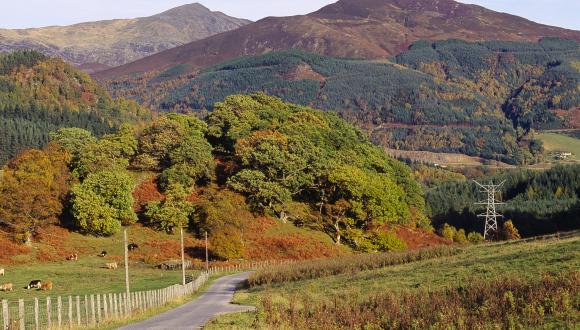Evaluation and monitoring of the Agri-Environment and Climate Scheme
The Agri-Environment and Climate Scheme (AECS) forms part of the Scottish Rural Development Programme 2014-20. It represents Scotland’s most important investment for securing environmental benefits for Scotland’s land. About £30-40 million is awarded annually to land managers. It contributes to deliver national and international targets relating to biodiversity, climate change, water quality and flooding, and also supports organic farming, the historic environment and public access. For the year 2020, one-year extensions were offered to those with expiring contracts, and for 2021 the application round was focussed on key priorities. Key figures:
- over 3,200 farmers, crofters and land managers have AECS contracts out of the regular 18,000 CAP claimants
- covers 1,16 million hectares of agricultural land under management contracts representing about 20% of agricultural land.
- delivers biodiversity and climate change benefits from management of arable land, grasslands, peatlands and carbon-rich soils, designated sites, pollinators, wetlands and moorlands.
Monitoring of the Biodiversity outcomes of the Scheme
During 2019-20, NatureScot commissioned the James Hutton Institute to carry out some work to monitor the biodiversity benefits and impacts of the scheme looking at a selection of case studies. The report Evaluation of the Biodiversity outcomes of the 2014-20 SRDP Agri-Environment Climate Scheme through a selection of case studies is now available in an accessible format.
Geographic Uptake of the Scheme
During the same period NatureScot produced a series of heat maps to understand better the geographic distribution of scheme uptake. NatureScot Research Report 1285 - Agri-Environment Climate Scheme Heat Maps Report 2015-18.
Summary
Scotland’s Agri-Environment and Climate Scheme Summary provides a summary for the public of the results of the two projects.
Findings
During 2019-20 we looked at uptake of the scheme for the 2015 to 2018 rounds (the first four years of the scheme) to understand the impacts and potential benefits of the scheme. Management contracts are for 5 years, so these four rounds cover the period 2016 to 2023. Highlights included:
- Arable Farmland and Birds – key management options that provide food for farmland birds have had a good uptake across the whole country. Many of these management activities also deliver water quality benefits. The area covered by key options for arable farmland birds was about 13,800 hectares with £31.6 million committed.
- Designated Sites – the scheme has a major role in helping to deliver the favourable condition of designated sites (SSSIs and Natura). About 621,444 Hectares are under positive management through AECS with, 1,399 contracts and a total budget of £45 million committed.
- Key vulnerable species – the scheme is making significant strides in helping address the decline of vulnerable species such as corncrakes, corn bunting and waders. The combined area of land managed for waders, including the provision of cover and food for their survival, was estimated as more than 48,880 hectares with a committed funding of more than £30.5 million. Funding was widely distributed including ‘hot spot’ areas in Caithness, Speyside, the Islands (Western Isles and Orkney), and parts of the North East, Central and South Scotland. Other key vulnerable species such as corncrakes have a more restricted range focussed on remoter area such as the Outer and Inner Hebrides, and Orkney. Over £4 million committed with 2,464 hectares under management.
- Pollinators – Farms within AECS had a higher number and diversity of pollinators with a significant number of options providing habitat for pollinators including hedgerow management and creation, wild bird seed, water margins and species rich grassland.
- Water Management – the scheme supported arable and grassland water margins to help improve water quality estimated at more than a 1,060 hectares with a committed funding of £6 million during the period. These interventions are targeted at catchments identified as having diffuse pollution or poor water quality.
- Grassland Management, Habitat Mosaics and carbon rich soils – More than 26,140 hectares of species rich grassland and habitat mosaic managed under the scheme with a committed funding of more than £20 million. These are some of the most diverse habitats which, without this support, are more likely to decline or disappear. Uptake of Species Rich Grasslands management and creation has been high across the country including parts of North and West Scotland, the North East, Islands and the Borders.
- Carbon rich soils and Climate Change – An estimated 7,400 hectares of carbon rich soils (lowland bogs and wetlands) were managed under the 2015-18 rounds with a £5 million budget and contributing to climate change and biodiversity targets. A cluster of contracts were in the Caithness and Sutherland peatland area, the largest blanket bog in Europe - a key carbon store in Scotland and at international level. Peatland restoration capital work was also funded under AECS with a £2.3 million budget spent or committed during this period.
- Moorland Management and climate change – About 653,079 hectares of upland moorland and heath is managed under the scheme with £27.4 million committed to help achieve biodiversity and climate change benefits.
- Hedgerows – The combined area of Creation and or Management/Restoration, of Hedgerows is estimated at 1,214,700mtrs, with more than £8.4 million funding allocated, and contributing to increased habitat connectivity across the landscape.
- Organic Farming – A key achievement of the scheme has been supporting land under organic management, with 52,258 hectares of land managed or converted to organic farming with £15.8 million budget allocated under the scheme during the 2015-18 period.






